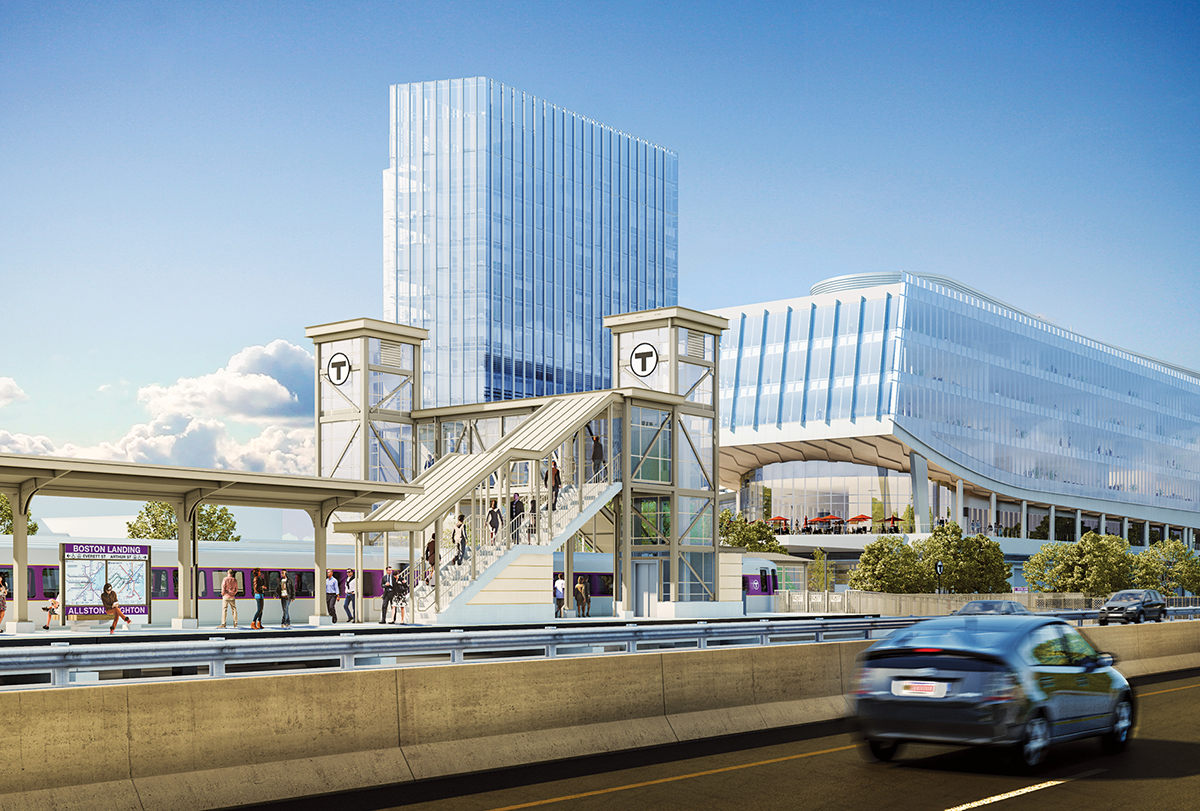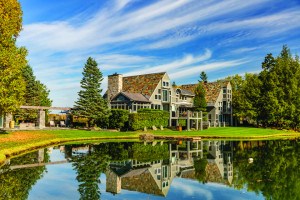The Future Is Brighton

Image by Neoscape
Head west on the Mass. Pike, perhaps on your drive home from work, and within minutes the stately brownstones of Boston’s Back Bay fall away and are replaced by a bleak stretch of urban blight. Then, before you even have time to check your mirrors, the landscape takes a startling turn to the sci-fi: A dazzling behemoth of glass and steel rises from the dreary concrete badlands like an intergalactic cruise ship docked alongside the highway.
You’d be forgiven if your first thought was, What the hell is that?
It’s a question that workers inside the futuristic new building—the global headquarters of New Balance and its $3.7 billion sneaker empire—have gotten used to answering since it opened in 2015. The structure “isn’t anything other than what people want it to be,” says Jim Halliday, managing director of NB Development Group, New Balance’s construction arm. “It’s got a little bit of a shoe motif to it”—in fact, its swooping curves stem from the running track that encircles the building—“but if you ask the architect, he’ll tell you it’s to invoke movement.” It also so happens to be a striking symbol of change for the area.
Brighton has long amounted to Boston’s take on flyover country. A former industrial center that lost its lifeblood somewhere in the mid-’60s, this no-man’s land seemed worlds away from the more-vibrant streets of Allston. Before the Mass. Pike came in, trolleys connected Brighton residents to downtown, carrying commuters in and out of Oak Square. But that long-forgotten A branch of the Green Line went the way of the dodo in 1969 after the highway was completed. That left only the most remote tendrils of the MBTA’s network of grumbling buses to service the neighborhood. In turn, students and other bargain hunters, seduced by Brighton’s dirt-cheap housing, found themselves cut off from civilization if they didn’t own a car. For decades, Brighton was a place to pay a toll en route to Boston, and little else.
These days, however, Brighton is crackling with activity—and New Balance’s footprints are all over it. In “Boston Landing,” CEO Jim Davis’s 1.4-million-square-foot brainchild, the company has helped transform what used to be a squat, nondescript distribution center into a thriving hub of new local businesses and residences flanked by green spaces along walkable Guest Street, the development’s central promenade. Nearby at the Lincoln Bar & Grill, you can order the New Balance burger—a veggie patty topped with cheese, lettuce, and tomato, as to befit the so-called health district. Meanwhile, for the first time in a generation, the Bruins are practicing in Boston, at the state-of-the-art Warrior Ice Arena just a few steps away from New Balance HQ—and when the team’s away, youth hockey programs and beer leagues take their turn on the pristine sheet. Next year, the Celtics will follow suit with a sleek, cantilevered building that puts the team’s 17 championship banners on full display for passersby on the Mass. Pike. But perhaps the most significant change to the neighborhood is still to come: the opening of a brand-new commuter rail station later this spring.
Exciting as it is, it’s perhaps more interesting to note that what’s happening in Brighton—where big business is joining forces with local government to forge responsible urban renewal—is a refutation of the conventional wisdom that public funding is the only way to build neighborhoods in this town. You want public transit? Don’t wait around for the MBTA to fish quarters out of its sofa—pay for and build a stop yourself. Ditto for sidewalks and streets. In fact, if Boston Landing is any indication, public-private partnerships could be the key to ensuring that as companies benefit from their new Boston pads, so do their communities and surroundings. Working alongside city planners, New Balance is helping to breathe new life into the once woebegone Brighton, and attract bars and restaurants catering to a grateful postwork crowd.
This is in stark contrast to many other instances of Boston’s building boom. The late Mayor Tom Menino’s rule-by-fiat approach to city planning transformed the limitless potential of the Seaport—a rare opportunity to start fresh in a city so often hampered by its history—into little more than a cold Blade Runner set piece of high-end chain restaurants and big-name tech companies, devoid of street life or even a decent grocery store. Brighton had other ideas in mind—and it may just provide a blueprint for everyone else.
Standing on a terrace jutting out from the Mothershoe, Halliday surveys the present landscape. Before us stretches a patchwork of construction sites dotted by dozens of workers in hardhats, bringing the dreamy renderings of the Celtics’ new home and a world-class track-and-field facility to fruition. But Halliday also sees the past. New Balance, he points out, is by no means a newcomer to Brighton. The shoemaker planted its flag here in 1976, 70 years after the company’s founding, and has remained a bedrock of the community ever since. Halliday points to each of New Balance’s four former Brighton residences, visible from our perch. “It was an industrial area that was dying,” he tells me. “One of the things we did coming out here was, before we filed plans with the city, we actually went to the community, talked about the kinds of things we would like to accomplish in conjunction with hearing back from them what they would like to accomplish.”
This fusion of past and future is part of the headquarters itself. Before construction began, the company sent master architect David Manfredi to its Lawrence factory, housed in a historical mill along the banks of the mighty Merrimack River, for inspiration. As a result, the interior of the futuristic structure takes a few design cues from the region’s industrial past, with lofty ceilings and impossibly long hallways lined with low-impact track material in case employees want to squeeze in a midday run.
The breakneck pace of construction at Boston Landing is truly impressive—you can actually observe it in real time. Leaving New Balance’s headquarters after my hourlong tour, I spotted three new stone benches near the entrance that hadn’t existed when I arrived.
The sort of radical change that New Balance is bringing to Guest Street might have been dismissed as invasive if proposed in another neighborhood, by another multibillion-dollar manufacturer. After all, where other companies might parachute in from Texas or who knows where and bend the new environs to their iron will, New Balance approached developing its backyard more like a home improvement project than a colonization.
Of course, it’s not strictly altruism—it’s shrewd business strategy. “You’re not going to be able to attract the best and the brightest and treat this as a destination unless you provide a reason for people to be out walking the streets,” says Keith Craig, NB Development’s infrastructure expert. “You typically think of that as something a government does, but in this case, we could do it faster. We wanted to do it our way.”
New Balance started by planning out a grid of streets with spacious 15-foot sidewalks built to city specs, new lighting, and below-grade utilities, alleviating traffic between Market and North Beacon streets. Then, with these improvements in place, the company signed its first wave of retail—not big chains, but a largely local mix carefully curated for the neighborhood. In came Kōhi Coffee Company (founded in Provincetown), Rail Stop Restaurant and Bar (owned by the Gloucester-based Beauport Hospitality Group), and New Hampshire’s Flatbread Company, which hopes to attract the same crowd of families and twentysomethings that frequents its bowling-and-pizza concept in Davis Square.
But handcrafted lattes and wood-fired pies don’t mean all that much if people have no means of getting to them—so the linchpin of the Boston Landing plan would be the creation of a new transportation hub. Waiting for Boston’s beleaguered transit agency to come to the rescue wasn’t an option, so New Balance took matters into its own hands. “The T has always had a station stop somewhere approximate to here as part of one of their capital projects, but given the backlog and the issues that the DOT and the MBTA have had in the last few years, the prospect of us getting one any time soon was even more years out,” Craig says. “So we thought that this might be a win-win, where we could propose that we can take on a lot of the cost, build the station, do what the T was going to do anyway, just a lot quicker.”
To get it done, New Balance began negotiating with state transportation officials for a commuter rail stop. Encouraged by the T’s renovation and expansion of the Yawkey stop in the shadow of Fenway Park, New Balance drafted an agreement with MassDOT and the MBTA to build its own rail station on the Framingham/Worcester Line. In October 2015, construction crews broke ground. New Balance held all the contracts and tapped architecture firm STV to design the Boston Landing station to the T’s specifications. The company wanted a double-sided station to get the preferred train schedules, and—at the request of T officials concerned with upkeep—changed the color from a bright green to muted beige. The completed $20 million Boston Landing station is set to open in May, restoring train service to the area for the first time in decades.
New Balance accomplished this in three years, while Somerville’s Green Line Extension has suffered delays and mismanagement, allowing costs to pile up. Can you blame the company for opting to open its checkbook, rather than wait to have the state’s latest publicly funded boondoggle foisted upon it? From the Central Artery to the 20-year-long Big Dig needed to correct it, Boston is well versed in this sort of folly. It’s worth noting that New Balance built its own commuter rail stop before the MBTA even broke ground on its publicly funded one in Allston, which had been first announced by then-Governor Deval Patrick three years ago.
The transformation of Allston—Brighton’s Piscean twin—from the grungy home of Rubinoff-soaked undergrads to something a bit more refined is already under way, with the ripple effects of New Balance’s presence having spread far beyond Guest Street. “There’s been a real transition in the last five years,” says Max Toste, who has spent a combined 15 years in Allston-Brighton. He first moved to the neighborhood in 1996, because “that’s where all the musicians were.” Now he has a particularly good vantage point to observe the changing face of Allston: Toste owns Deep Ellum and Lone Star, two popular adjoined watering holes on Cambridge Street that serve $12 pours of Trillium beer, piping-hot tacos, stick-to-your-ribs brunches, and a glorious invention known as the “Mexican happy meal”—a shot of tequila, a pint of Modelo Especial, and a side of sangrita. Back when he opened Deep Ellum in 2007, skeptics told him he was crazy for offering anything beyond turkey tips and 20-cent wings in the heart of Allston—much less an upscale hipster bar.
Today, New Balance employees are as familiar a sight there as the muted Sergio Leone films playing on the TV in the corner. “There’s been this interesting demographic shift. I’ve noticed the neighborhood is majorly in flux,” Toste says. “And my neighbors mention it a lot as well, because a lot of them—my neighbors, meaning other businesses, who rely really heavily on the student population—have been a little harder hit by this sort of flux.”
Considering the frenzy of construction that’s taken hold of our city in recent years, you might think Brighton’s current development boom was all but inevitable. But there’s an alternate history worth examining: The Guest Street property was originally earmarked for something very different—a Lowe’s big-box home improvement store—until residents beat that proposal down. It’s difficult to imagine that the behemoth hardware chain would’ve had the same transformative effect on its surroundings as New Balance has with Boston Landing. Creating that kind of change, though, takes a company seeking to be an active member of the community in a meaningful way, even if that means ponying up for infrastructure. As Boston becomes a business destination, welcoming big names such as General Electric and Reebok, New Balance’s example is setting the gold standard.


